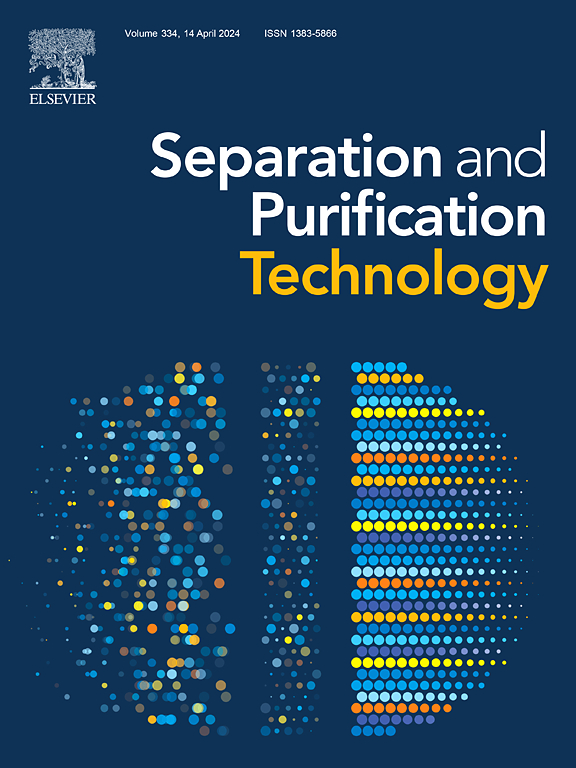易于合成的MnZryOx固溶体增强低温选择性催化还原NOx
IF 8.1
1区 工程技术
Q1 ENGINEERING, CHEMICAL
引用次数: 0
摘要
制备具有优良低温活性和活性-温度窗口的锰基催化剂用于NOx的选择性催化还原(SCR)仍然是烟气脱硝领域的一个艰巨挑战。本文采用溶胶-凝胶法设计合成了一系列Mn/Zr比可控的MnZryOx固溶体(MZOSS)催化剂,并研究了其对NOx NH3-SCR的催化性能。通过一系列表征技术证实,所制备的催化剂具有明显的固溶体性质,Mn和Zr的可调组成和协同作用对MZOSS催化剂的氧空位浓度的形成、活性氧种类的数量、表面酸度和氧化还原性能有显著影响。其中,MnZr4Ox稳定性强,耐碳氢化合物性能优异,同时消除VOC和NOx活性优异,在107-265 °C的温度范围内,NOx转化率达到90% %以上,具有优异的催化效果,超过了当代大多数研究成果。通过原位漂移光谱进一步研究发现,适当的Zr/Mn比例有利于生成双齿态硝酸盐和ad-NO2等活性硝酸盐,这些硝酸盐主要通过L-H反应机制加速低温SCR速率,从而大大提高MZOSS催化剂的NH3-SCR性能。然而,较高的Zr/Mn显著提高了表面酸度,抑制了吸附的NH3/NH4+的解吸,从而严重抑制了相应MZOSS催化剂的低温NH3- scr活性。因此,本研究提出了一种通过调节MZOSS的组成来制备高效低温NH3-SCR催化剂的简单策略。本文章由计算机程序翻译,如有差异,请以英文原文为准。

Facile synthesis of MnZryOx solid solutions for enhanced low-temperature selective catalytic reduction of NOx
The fabrication of manganese-based catalysts with excellent low-temperature activity and outstanding activity-temperature-window for selective catalytic reduction (SCR) of NOx remains a formidable challenge in the field of flue gas denitrification. In this contribution, a series of MnZryOx solid solution (MZOSS) catalysts with controllable Mn/Zr ratios were elaborately designed and synthesized by a sol–gel protocol, and their catalytic performances for NH3-SCR of NOx were investigated. It was confirmed by a series of characterization techniques that the present catalysts have the distinct characteristics of solid solution and that the tunable composition and synergistic interaction between Mn and Zr has a significant effect on the formation of oxygen vacancy concentration, active oxygen species amount, as well as surface acidity and redox properties of the MZOSS catalysts. Among them, MnZr4Ox shows roust stability, excellent hydrocarbons resistance, superior simultaneous elimination of VOC and NOx activity, and superior catalytic efficacy with above 90 % NOx conversion across the temperature range of 107–265 °C, surpassing the majority of contemporary studies. Further investigation of the mechanism by in-situ DRIFTS spectra unveil that the appropriate Zr/Mn ratio is favorable to the generation of reactive nitrates, such as bidentate nitrate and ad-NO2, which in turn accelerate the low-temperature SCR rate mainly through the L-H reaction mechanism, thereby greatly improving the NH3-SCR performances of MZOSS catalysts. However, the higher Zr/Mn notably increases the surface acidity and inhibit the desorption of adsorbed NH3/NH4+ species, thereby seriously suppressing the low-temperature NH3-SCR activities of corresponding MZOSS catalysts. Therefore, this work presents a facile strategy to prepare efficient low-temperature NH3-SCR catalyst by regulating the composition of MZOSS.
求助全文
通过发布文献求助,成功后即可免费获取论文全文。
去求助
来源期刊

Separation and Purification Technology
工程技术-工程:化工
CiteScore
14.00
自引率
12.80%
发文量
2347
审稿时长
43 days
期刊介绍:
Separation and Purification Technology is a premier journal committed to sharing innovative methods for separation and purification in chemical and environmental engineering, encompassing both homogeneous solutions and heterogeneous mixtures. Our scope includes the separation and/or purification of liquids, vapors, and gases, as well as carbon capture and separation techniques. However, it's important to note that methods solely intended for analytical purposes are not within the scope of the journal. Additionally, disciplines such as soil science, polymer science, and metallurgy fall outside the purview of Separation and Purification Technology. Join us in advancing the field of separation and purification methods for sustainable solutions in chemical and environmental engineering.
 求助内容:
求助内容: 应助结果提醒方式:
应助结果提醒方式:


